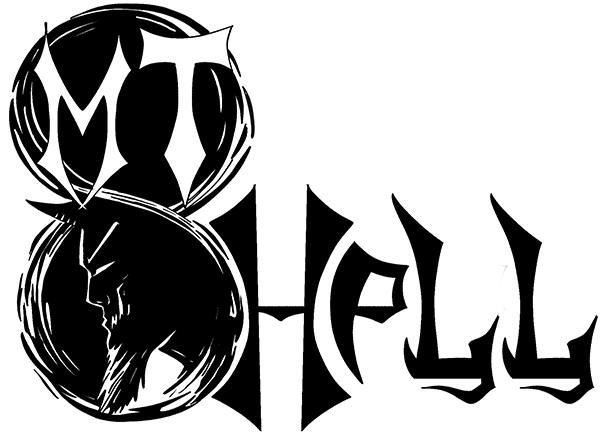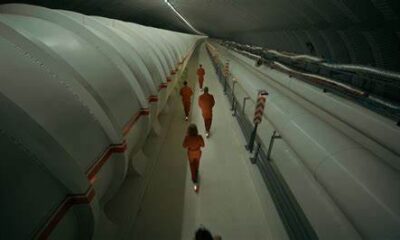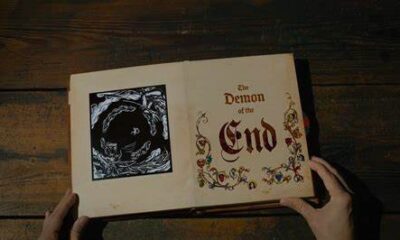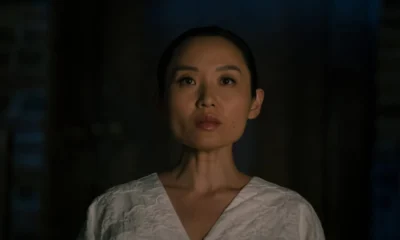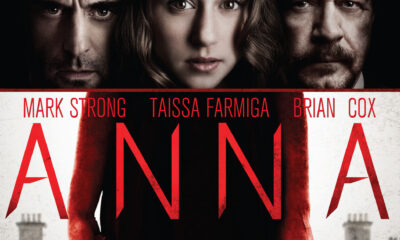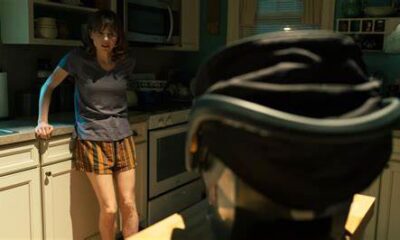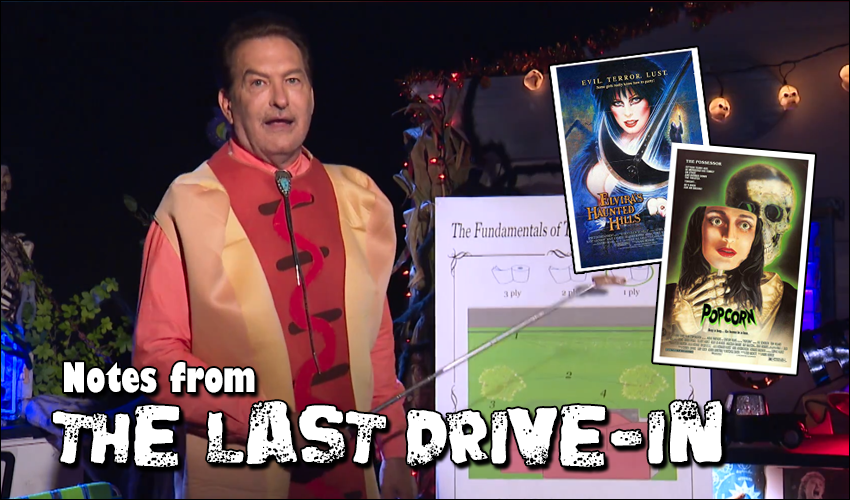
Notes from the Last Drive-In: Joe Bob’s Haunted Halloween Hangout
Grab your bags of candy corn boys and ghouls, for it is time for The Last Drive-In: Joe Bob’s Haunted Halloween Hangout. Shudder’s horror host unveils two cult films this Halloween: Elvira’s Haunted Hills (2001) and Popcorn (1991). Even better, he invited special guests Cassandra Peterson and Jill Schoelen to enjoy all the fun. How does this special stack up to previous engagements?
Let’s find out what Shudder had on offer on October 21, 2022.
Elvira’s Haunted Hills (2001)
The first film of the Haunted Halloween Hangout was the highly campy 2001 pseudo-sequel to Elvira: Mistress of the Dark (1988) that takes the favorite horror hostess and puts her in a classic horror story set in the Carpathian Mountains of Romania in 1851. The film plays fast and loose with Elvira’s modern, bawdy affect contrasting with the relatively-straight players around her involved in a family conspiracy in a decrepit estate. The film stars Cassandra Peterson as Elvira and a secondary role as a departed Lady of the House. She is joined by Richard O’Brien, Mary Scheer, Scott Atkison, Mary Jo Smith, and an uncredited cameo from voice actor Rob Paulson.
Peterson co-wrote the script with recently-departed Groundlings alumnus John Paragon, whom she would often work with. Most of the cast is pulled from the Groundlings as well. Director Sam Irvin took to the Roger Corman pastiche nature of the film and did a fine job playing the narrative straight and allowing Peterson’s Elvira to disrupt what is a pretty solid Gothic horror story. For a budget film entirely self-funded by Peterson and her then-husband Mark Pierson, the film also looks great when it needs to and noticeably cheap when it is most funny. Thankfully, Cinematographer Viorel Sergovici, a native Romanian, knew precisely how to utilize the on-location landscapes.
Chewing the Cardboard
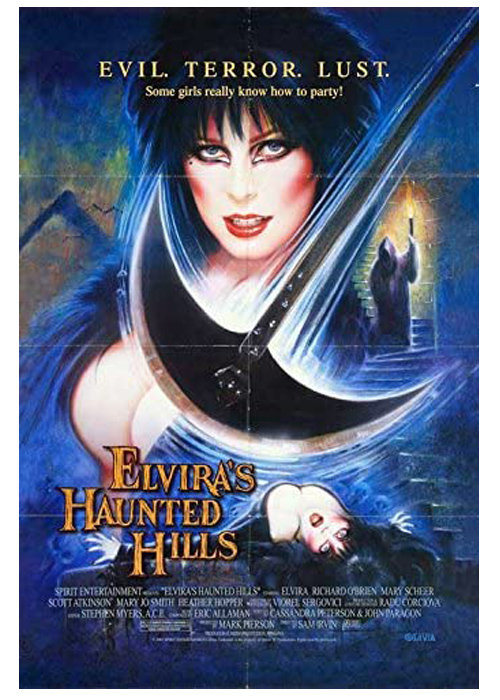
Comedy-wise, this sort of film appeals to me. Some horror-hardcores may grumble about an Elvira comedy taking up a “Halloween Special Slot,” as though such a thing even exists. The jokes are widely inspired by bawdy, campy stage shows and are nothing many have not heard before. The real joke is how we buy into the film. Such as Peterson’s iconic character hanging the lampshade on and chewing the scenery of the kind of technicolor late-night horror many of us grew up with. It’s why Mystery Science Theater 3000 refuses to die. The old stuff is beloved, whether it is a gothic murder house or a burlesque joke.
I need to mention the role of Adrian, the Stable Stud, an unintentionally collaborative performance that earns the biggest laughs in the film. The seriousness of Romanian actor Gabi Andronache playing a character utterly straight with Rob Paulson’s hilariously dubbed voice is some of the funniest stuff I have ever experienced on The Last Drive-In.
With that said, the satiric edge of Elvira: Mistress of the Dark is missing here. Elvira’s Haunted Hills trades essentially in farce and, while fun, is ultimately not as great as the first film. The first film has a little more heart. This one is more of a parody but doesn’t offer much more than some teasing of a genre and style. That being said, they tease it nearly as much as Elvira’s hair.
Joe Bob-servations on Elvira’s Haunted Hills
This year’s Halloween theme was the same as the past two Drive-In Halloween specials: namely, making up for the perceived lack of Halloween in previous specials. I think this has been mined a little much, but it still leads to some fun. I think the show is beginning to grow slightly referential instead of finding new angles. So much conversation between Joe Bob and Darcy was filled with things we’ve heard on the show a few times before. While I won’t say lazy, I would say undercooked. Ironically, spending a year in a cabin for “social distancing” produced some exciting material compared to recent forays back to the trailer set.
I also felt that the “airplane light” bit was slightly overlong. As fun as it was, the conversation could have been a bit tighter, and the director could have exercised more control in moving things forward. The breaks featuring Halloween trick-or-treat tips were neat and provided plenty of fun little Halloween references. Of course, the conversation with Cassandra Peterson was excellent, but I’ll discuss that further in the review.
Final Thoughts on Elvira’s Haunted Hills
Elvira’s Haunted Hills is an enjoyable farce of a film. The pastiche of the Roger Corman 1960s Poe adaptations creates an inherently limited audience, but this movie will land for them. The film skirts the line between gorgeous and budget where it needs to as well. Meanwhile, Cassandra Peterson’s Elvira does what is expected and decimates the fourth wall with jokes older than the castle where the film takes place. The film may lack the bite of her first film, but it is still an excellent watch for a Halloween party before you dig into the creepy stuff.
Joe Bob Briggs gave Elvira’s Haunted Hills three stars. I feel the film is a strong one, but it may have a more limited appeal and lacks a little edge, so I am giving it four Cthulhus. A fun opener for the Haunted Halloween Hangout.
 (4 / 5)
(4 / 5)
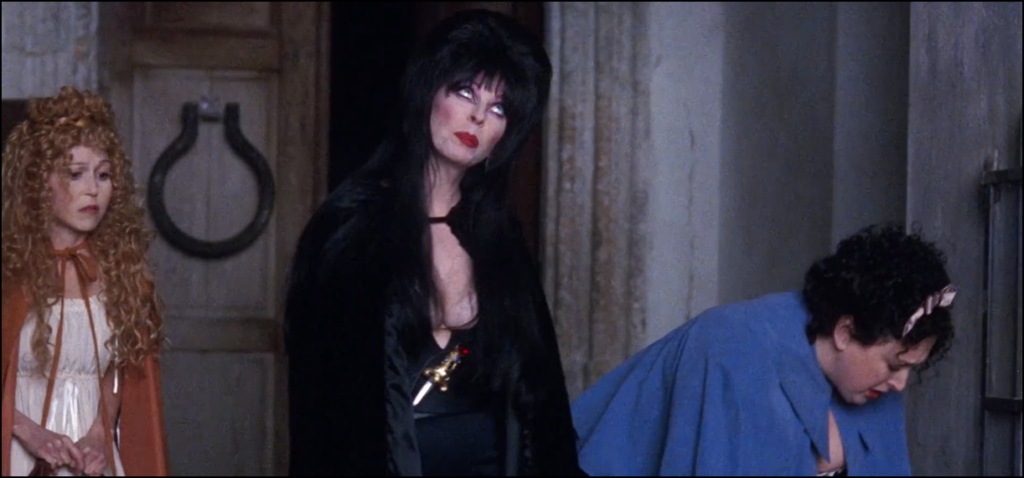
Best Line: “Honey, when I spend the night in a man’s room, he’d better pay me.” – Elvira
Popcorn (1991)
The second film of the night, 1991’s Popcorn, is a somewhat debated cult classic with complex production history. The film follows a ragtag group of kids who put on a film festival full of William Castle gimmicks. Only to seal their doom as someone starts killing them off. It’s a fun set-up overshadowed by the short films seen in the theater with a raucous audience. It is this which the film is most memorable, which is a shame. Outside of the short movies and aside from some strange moments, there is a golden kernel worth acknowledging.
The film’s production history is incredibly troubled. You might best understand it by watching Joe Bob discuss it with lead actress Hill Schoelen. Yet there are still many questions surrounding it. While Bob Clark produced the film, he didn’t want to direct it and pitched longtime friend Alan Ormsby. However, Ormsby would be fired as he bogged down filming the short films. Porky‘s actor Mark Harrier replaced him. Around this time, the initial lead of the film was played by Amy O’Neill (Honey, I Shrunk the Kids) but would be replaced by Jill Schoelen for unknown reasons. All of this occurred as the film was shot in a dilapidated theater in Kingston, Jamaica.
With that said, the “final” credits of the film include Mark Harrier as director, with uncredited sequences from Alan Ormsby and even Bob Clark, funny enough. The story was written by Mitchell Smith and adapted to a screenplay by Ormsby. The film would star Jill Schoelen, Tom Villard, and Dee Wallace. Ronnie Taylor would handle cinematography in one of the strangest gets for the film. The same Ronnie Taylor handled cinematography on Gandhi (1982) and A Chorus Line (1985).
“Who are we looking for?”
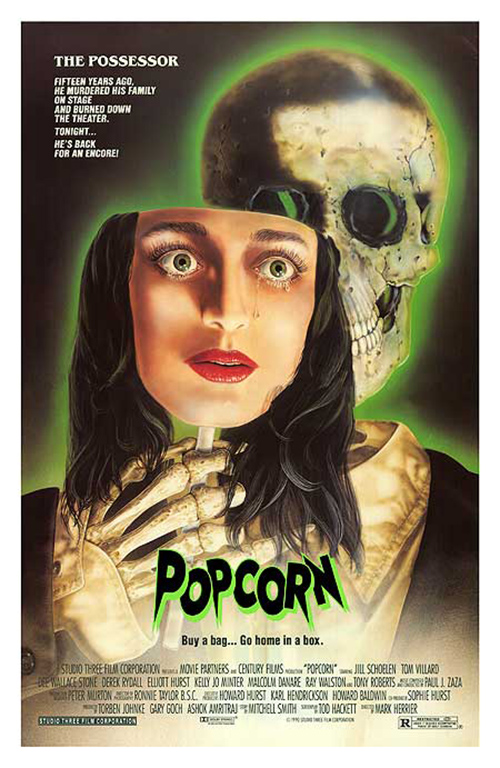
Popcorn is a mess; the issues in production would bleed into the film and confuse what is a decent enough premise. The three short films are excellent; the raucous reaction of the audience is a highlight. Yet, the connective tissue is lacking. The film does several odd things, and some are fun, such as a spontaneous reggae show. I have the impression that Bob Clark desperately tried to save the film, given the mess in production. However, he was also displaced enough from it to let Harrier take the credit. The film does try to course-correct a bit, but it is ham-handed. The hilarious scene depicting convenient newspaper clippings in chronological order comes to mind.
The performances are where the film shines. Jill Schoelen and Dee Wallace are great, though Wallace’s role is somewhat familiar and limited, given the movie. Schoelen was admirable as a lead, working with an already uncomfortable and awkward shoot. The actual performance that saves the film is Tom Villard as Toby. Villard’s work in the movie is excellent – his presence, when unleashed fully, is magnetic, and he takes to the prosthetic makeup incredibly well. Popcorn shows him as a talent taken far too soon by complications due to AIDs. He died just three years after the release of Popcorn at the age of 40.
The film has an offbeat quality to it that I feel would have paired better with The Monster Club, but it works for a more hammy, winking sort of Halloween special. I think the time is right for a Popcorn remake. The prop-skeleton is there; rebuild the tissue.
Joe Bob-servations on Popcorn
For the back half of the evening, Joe Bob switched from traditional trick-or-treating pranks to Samhain festivities (appropriately mispronounced, of course). These bits were fun, and the budget druid costume was a clever nod. The Samhain jokes were a nice addition and a fun way to get into the history of the spooky season.
With that said, the real highlight was the interview with Jill Schoelen, who had a lot of fun insights into Popcorn. There were also other important topics, but perhaps the best moment was when Darcy and Jill did their own smaller interview in the middle of one of the breaks. It very much felt like two friends talking. Joe Bob’s interviews can be hit or miss; he tends to do well when talking to longtime friends and old hands in the industry. He was good with both of tonight’s guests, but the ease at which Darcy and Jill spoke was quite illuminating.
Final Thoughts on Popcorn
I love Popcorn. It’s not a great film, but it is pretty fun. It is a little toothless, though. For being a 1991 film, it feels rather trapped in the 1980s. It is interesting to see this gasp of a dying genre before a reinvigoration by Scream. In many ways, it reminds me of Uncle Sam – a film out of time.
The film is fun to watch, don’t get me wrong. I prefer it to Uncle Sam. Still, it carries a lot of baggage that is never conducive to a strong film. I would give Popcorn three and a half Cthulhus.
 (3.5 / 5)
(3.5 / 5)
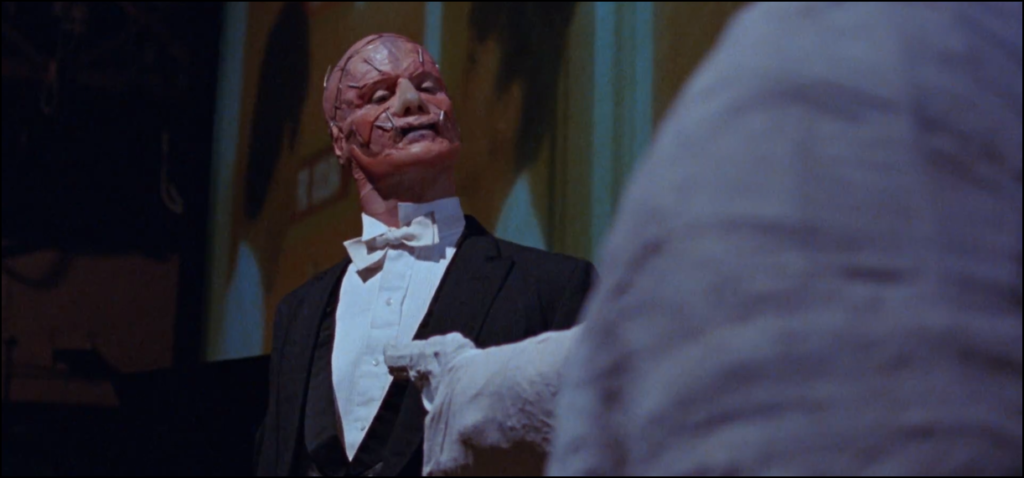
Best Line: “Without memory, there can be no retribution.” – Toby
Haunted MTL Drive-In Totals
As always, here are the official totals direct from Shudder’s Twitter account.
And we have our Drive-In totals revolving around the show itself. This week we have…
- 1 Yuki Sighting
- 2 Guests
- 5 Rounds of “Applause”
- 7 Utterances of “Penis”
- 8 Presentation Boards
- 13 Instances of “Thee-ate-er”
- Gratuitous Candy Corn Slander
- Gratuitous Mispronunciation of Samhein
- Gratuitous Airplane Light Bit
- Gratuitous Halloween Decorations
- Budget Costuming
- Checklisting
- Vampire Joking
- Halloween Joking
- Eyes Roll
- Plot Recap Fu
- Production Recap Fu
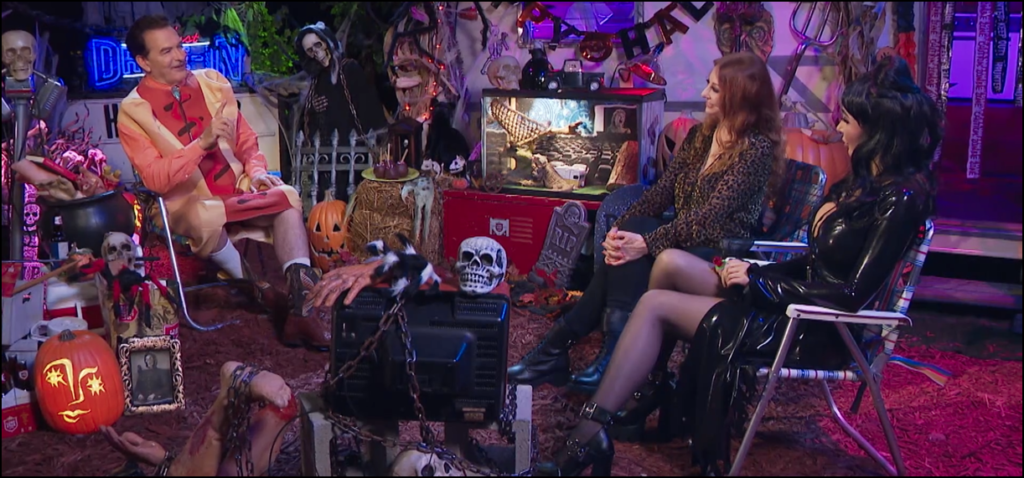
Episode Score for The Last Drive-In: Joe Bob’s Haunted Halloween Hangout
Overall, the evening was fun, and the two guests did a lot for the experience. Cassandra Peterson and Jill Schoelen were absolute delights. Darcy has an opportunity to take a more active role in the episodes, at least when it comes to specific guests. her friendliness and charm proved quite the asset tonight.
As for the Halloween trappings, they felt decidedly more low-key than usual, but I think it worked. The “Trick-Or-Treat” and “Samhain” tips were a fun, punchy little gag. I’m not going to be one to complain about the movies not being Halloween-appropriate. That doesn’t bother me. The most important thing is that they’re fun; Elvira’s Haunted Hills and Popcorn are just that.
We have been spoiled as of late, especially in season four, with some creative gags and musical numbers on the show. I can’t justify them being able to deliver that every time, but I think this is the first time y felt that an aspect of the show was dialed in. There were a lot of recurring references in place of jokes. After years of doing this sort of thing, it makes sense, but I also hope that tonight was a one-off.
For this special, I have to admit the guests drew me in more than Joe Bob and Darcy – but that was bound to happen at some point. You can’t crank out hit after hit forever.
I give the Haunted Halloween Hangout three and a half Cthulhus.
 (3.5 / 5)
(3.5 / 5)
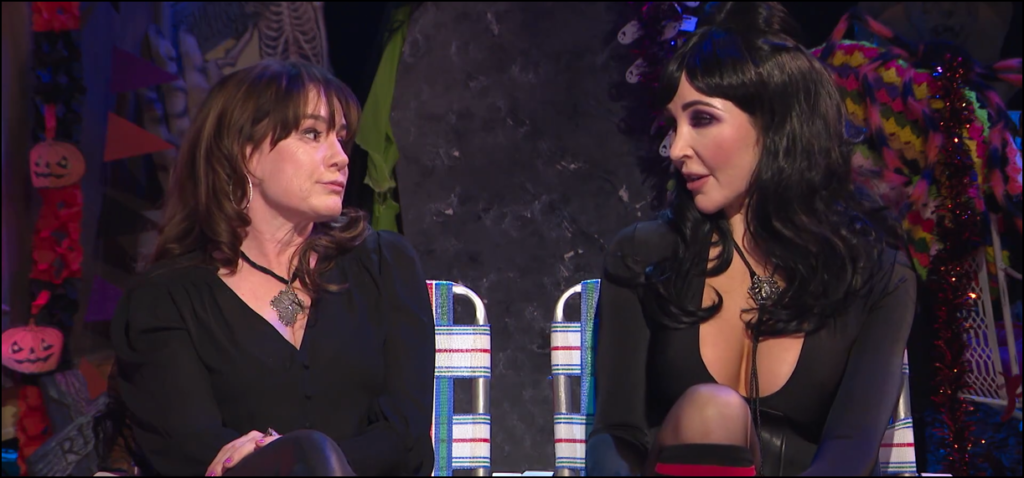
That is it for us here at Haunted MTL regarding Joe Bob’s Haunted Halloween Hangout. We’re looking forward to season five of The Last Drive-In and will continue to review, recap, and live-tweet the show. If you want to stick around for more coverage, look at our extensive coverage of Shudder, our favorite streaming service.
Please weigh in if you have some thoughts on the Haunted Halloween Hangout special. We’d love to hear them.
Movies n TV
Wheel of Time A Question of Crimson Is a Political Espionage Delight
Episode two of Wheel of Time felt like the beginning of a long journey. Stories are unfolding, lives are changing, and blood is spilling.
Let’s discuss.
The story
We begin this episode in the past with Elayne’s mother, Queen Morgase. It turns out her rise to the throne was a bit, shall we say, cutthroat. So when she shows up at the White Tower, Siuan is concerned.
She might have reason to be, too.
Meanwhile, Rand, Egwene, Moiraine, Lan and Aviendha are in the Spine of The World. As they travel through some of the most breathtaking lands I have ever seen on a TV show, Egwene is plagued with nightmares. We think at first that’s just her trauma working itself through her system. But we soon find out that it might not be that straightforward.
Finally, Perrin returns home to heal after his hand is almost cut in half. But when he gets there he finds the town has been infested by Children of The Light. And they’re looking for him.
What worked
There was something heartwarming in this episode about political espionage and choking religious persecution. And that is Elayne’s relationship with her family.
I have consumed a lot of fantasy content with royal families. And I have never once heard a princess call her mother ‘Mum’. I’ve never seen royal siblings get along. And I have sure as hell never seen a princess have a good relationship with her step-parent.
This was refreshing. Even though Queen Morgase is kind of a horrible person she seems like a good mother. And that’s an unexpected delight.
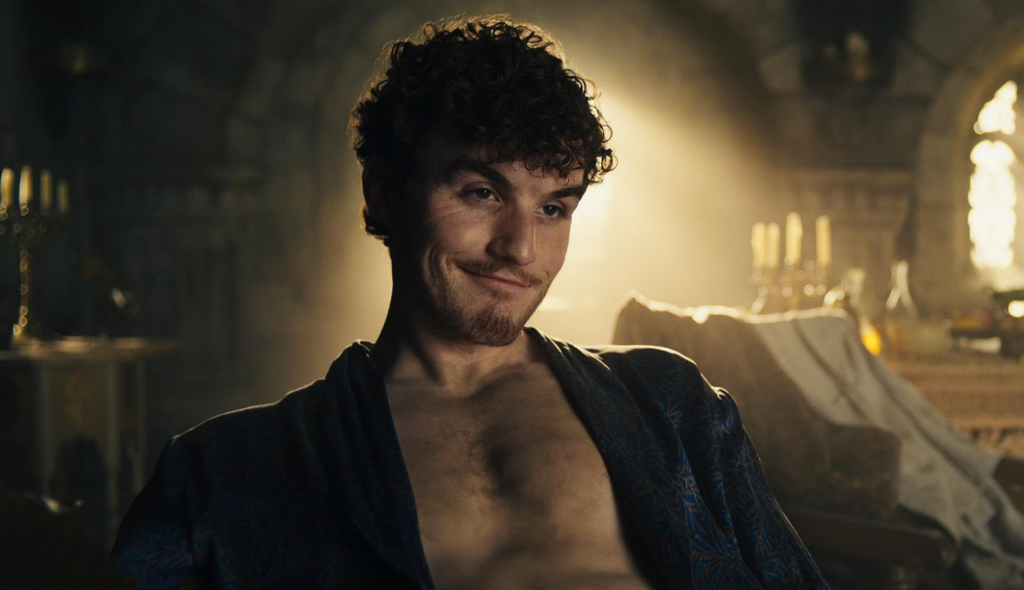
Of course, this is just one storyline among many. And while this can sometimes be overwhelming, in this case it wasn’t.
I’ll be honest, some of these storylines are going to drag for me. I know this because I’ve read some of the Wheel of Time books and I have an idea that not all the characters exactly pique my interest.
No one likes all the characters. No one likes all the storylines. While I am here for the political espionage between Queen Morgase and Siuan, not everyone likes it. While others might be fascinated with Selene trying to win Rand back, I couldn’t care less.
Having multiple storylines keeps everyone’s attention better. So long as things don’t get out of hand. Things can easily get out of hand. But this seems to be managed well.
So far.
What didn’t work
As I mentioned above, I’m not thrilled with Rand’s story at this point. And while it’s fine to not like a storyline when there are this many to choose from, it’s not fantastic that the one I like the least is the one involving our two main characters. And anytime we were with the team at the Spine of The World, the only thing that brought me joy was Moirain’s hat. It reminded me of Stockard Channing’s hat in Practical Magic.
The problem is that Rand is Charlie Brown with controversial magical powers. He is boring, serious, and pessimistic.
And yes, I understand that he has a heavy emotional burden and he’s the Dragon Reborn and that’s quite taxing and all. But let’s be fair, there isn’t a single person in this show that doesn’t have a heavy burden. And most of them manage to be fun occasionally.
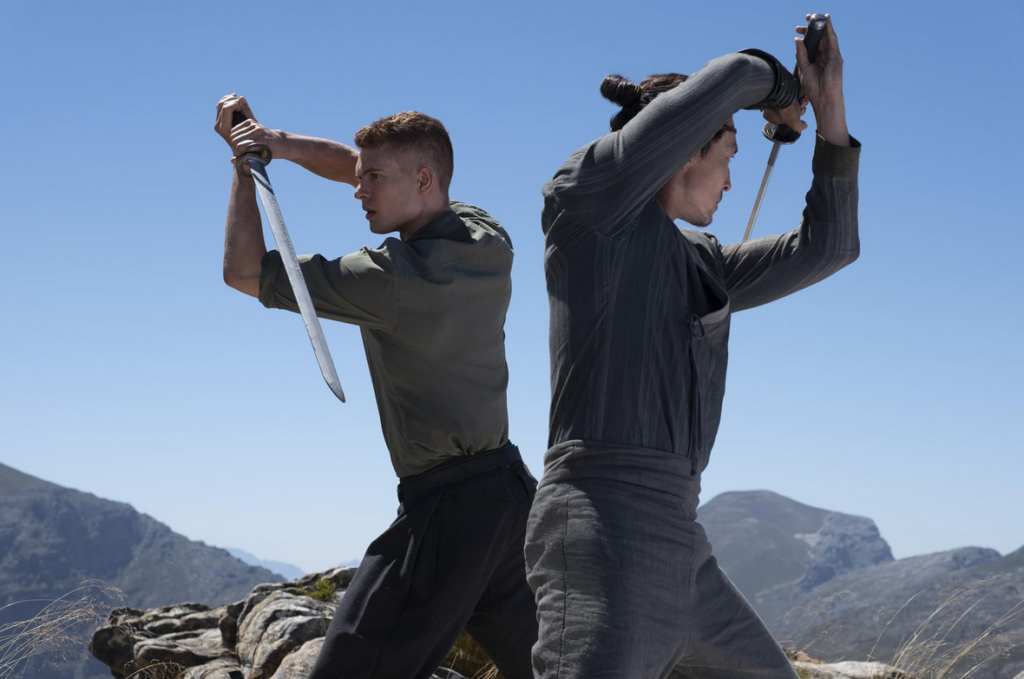
All that being said, this episode of Wheel of Time did exactly what it needed to do. It set up conflicts at each of the three locations. It established emotional ties between the characters and the events. And it established goals for everyone.
This was, in short, a solid episode. Not groundbreaking, not mind-blowing or life changing. It was simply good. It was entertaining and moved the plot forward.
Well done.
 (3.5 / 5)
(3.5 / 5)
Movies n TV
Wheel of Time Returns With A Bang
Wheel of Time is back for season three. There are mixed feelings regarding this. Last season, there were some serious pacing issues. And some serious sticking to the book’s storyline issues. But we’re two seasons in, and we don’t give up so easily. So let’s dive into episode one, To Race the Shadow.
By the way, I highly recommend watching this episode with the subtitles on. You’ll see why.
The story
We begin this episode with Liandrin facing a trial of sorts for her rampant betrayal. She does her best to gaslight her Aes Sedai sisters into thinking that Siuan Sanche is the real traitor.
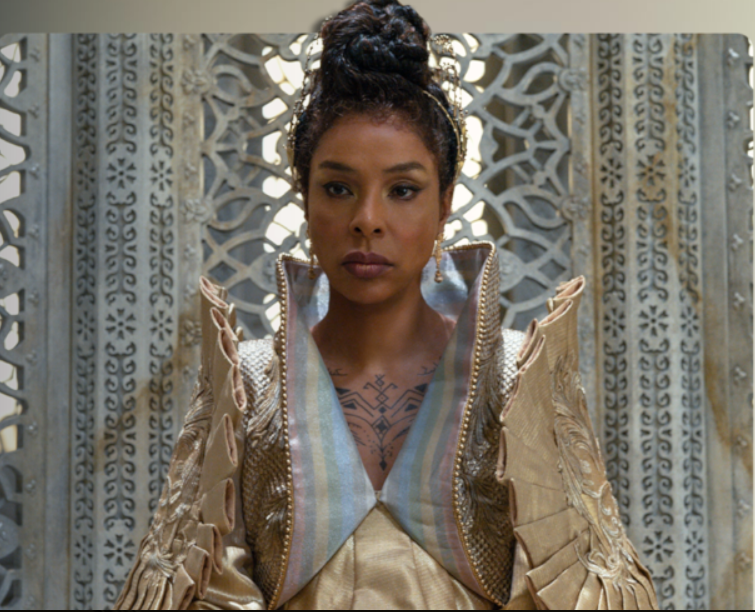
When that doesn’t work, she reveals how many Black Aes Sedai have actually infiltrated the tower.
Spoiler, it’s a lot.
In the aftermath, our whole team gathers to drink and enjoy one night of relaxation before they head out to the Tear to form an army for Rand. All is going well until they’re attacked by myriad creatures and a sentient axe.
What worked
This episode was long. It had a run time of an hour and eleven minutes. And a lot of that run time was spent in heavy dialog scenes.
Fortunately, these were well-done scenes.
If you’re going to have a lot of talking scenes, there are good ways and bad ways to do it. Last season, we saw lots of examples of the bad way to do it. But this episode did it well. For one thing, other things were going on while conversations were taking place. The characters are drinking, playing games, walking through an interesting city. And the scenes themselves didn’t stretch out. They weren’t repetitive. We heard what the character had to say, then we moved on.
It was also nice that the point of these scenes wasn’t just info dumps. We had character development. We had romantic interactions. We had plot development and foreshadowing.
Overall, this episode felt like what it was. A moment of calm before a storm.
Taking a step back, I’d be remiss if I didn’t address the fight scene at the start of the episode. Because it was epic.
The magic looked amazing. The martial arts that went along with it looked fantastic. The costumes were beautiful. It was just incredibly fun to watch.
More than that, it was emotional. We lost some characters in that fight that were important. And it was clearly emotionally shattering for many of our characters, who found themselves betrayed by people they trusted.
So many of them.
It was a great way to open the season.
What didn’t work
Despite that, this episode wasn’t without its flaws.
First off, there were a lot of dialog scenes. And they were good scenes, as I’ve already discussed. But it was one after another after another. And when your episode is, again, an hour and eleven minutes, it’s maybe a little much to have so much chit-chat. Couldn’t some of these conversations, important as they were, have been moved to maybe another episode?
Finally, I want to talk about Egwene’s travel through the arches.
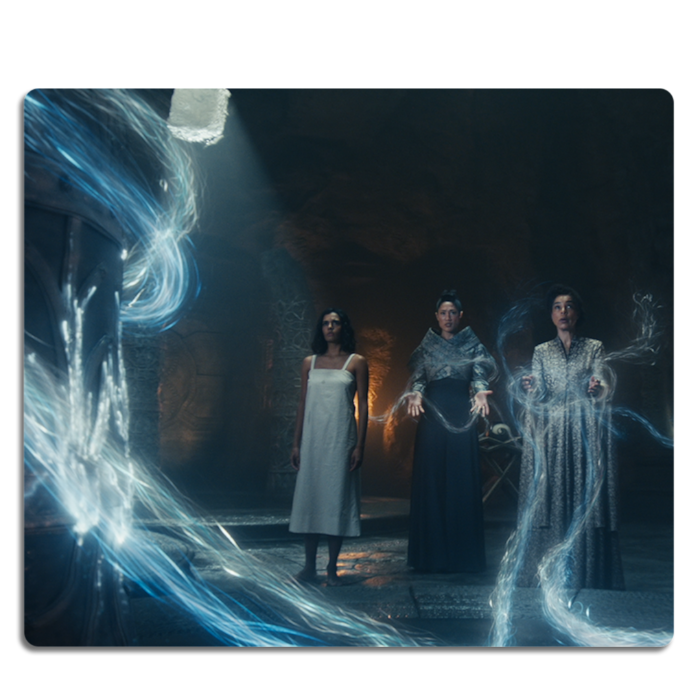
I feel like maybe there were some deleted scenes here. Because there must have been more to that visit than what we saw, right?
We could have seen Egwene battle Rand. That would have been badass and emotionally devastating. We could have seen her with a quiet life with Rand back home at the Two Rivers. We could have seen anything except for the quick clip of Rand in a bloody river, followed by Egwene being shoved back out in a bloody shift.
No products found.
Bad job. But at least it wasn’t an extended scene of Moiraine collecting bathwater, and then taking a bath while looking sad. If we’d started this season with another scene like that, it might have broken my brain.
Amazon dropped the first three episodes at once. So we’ll be back soon to talk about episode two. See you then.
 (4 / 5)
(4 / 5)
Movies n TV
Entertaining as hell: Eight Legged Freaks (2002) Review
Early 2000s is a special era for the industry. It accepts the cheesiness and corniness of movie making, in turn producing some gems in their own right. Eight Legged Freaks starring David Arquette and young Scarlet Johanson is a horror comedy about giant spiders who overtake a small town. As crazy as that premise sounds, the movie surprisingly has a ton of heart and is super entertaining. Let’s review, shall we?
Plot
We start Eight Legged Freaks with a shot of toxic waste spilling into the water supply of Joshua, a spider farm owner. He is friends with Mike, one of our protagonists, who is a science geek and a spider enthusiast. Mike notices something quite right upon visiting Joshua, but no one takes him seriously. We are then introduced to the rest of the crew. Mike’s mother Samantha, the town sheriff, is too busy chasing Ashley, his sister, who is dating the town mayor’s son Bret (something Samantha does not approve of). We also have Chris, who returns to the town to save his father’s legacy in the town mines. He has opposition from Wade, Bret’s father, who wants to use the mines for his business ventures. Lots of drama going on that will only get juicier once the spiders get loose.
The creepy crawlies quickly dispose of Joshua and make their grand appearance after Ashley rejects Bret’s advances, abandoning him in the middle of a desert. A glorious chase sequence ensues as the spiders make their way towards the town, wreaking havoc on its residents. In a true horror fashion (which the movie acknowledges), it takes some convincing from Mike and then from Samantha for the town to take the threat seriously. The tongue-in-cheek style of narrative adds the comedy aspect to a movie that would otherwise burn out fairly quickly.
The remaining characters hide out in a shopping mall as it’s the only somewhat sturdy building in the area. This doesn’t last long as the spiders break in, forcing them to run through the mines. Their resources to fight the creepy crawlies off are limited as the methane gas doesn’t allow them to use firearms. Such conditions require resourceful thinking from Chris, who uses perfume to fend off the leader of the spider group and save himself during the climax of the movie.
Character dynamics are not forgotten once the action kicks in. We have Chris confessing his long-term feelings for Samantha which she knew all along, which provided some comedic relief. Bret also reunites with Ashley and apologises for being an asshole. Mike finally gets the appreciation he deserves as his knowledge saves the townsfolk more than once during the whole ordeal.
We end the movie with the town’s radio show person telling the story as an urban legend during his segment. This brings it into question – how much of it happened the way he said it did? We can only guess…
Overall thoughts
Eight Legged Freaks is a fun creature feature with some self-aware commentary on genre tropes that doesn’t take itself too seriously. The acting is good, the pacing fitting and the characters are likeable enough for you to want them to make it through. Definitely a must watch, if you don’t suffer from arachnophobia, that is.
 (5 / 5)
(5 / 5)
- What do you get when you cross toxic waste with a bunch of exotic spiders? Eaten! The townies of Prosperity, Arizona will all become a screaming smorgasbord if mutated arachnids as big as SUVs have their way in this comedy/horror crowd pleaser whose creators include the producers of Independence Day and Godzilla
- Spiders that leap like gazelles, web-spitting spiders, spiders that suck your insides out as if through a straw—they’re all among the behemoths conjured up by an inventive effects team
- David Arquette (Scream) leads the two-legged stars, mobilizing the citizenry in a last-ditch fight to survive
Last update on 2025-03-10 / Affiliate links / Images from Amazon Product Advertising API

